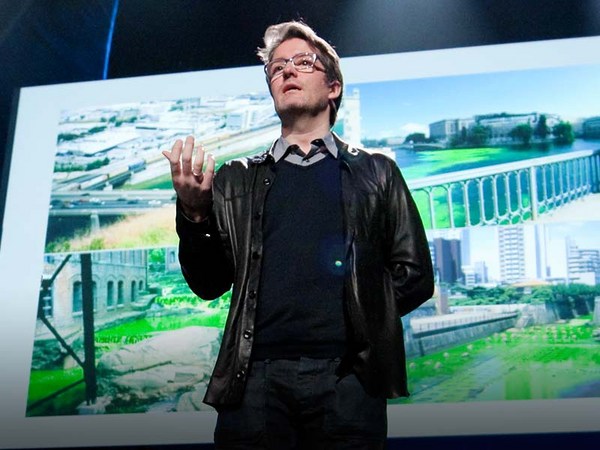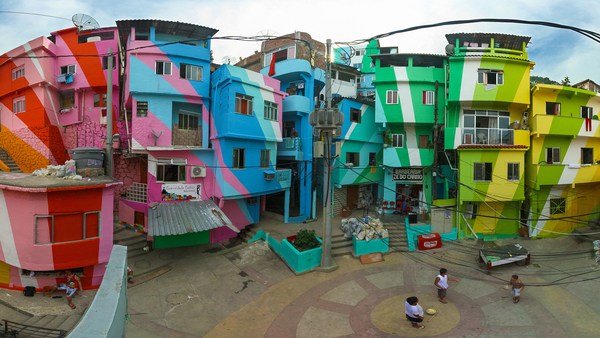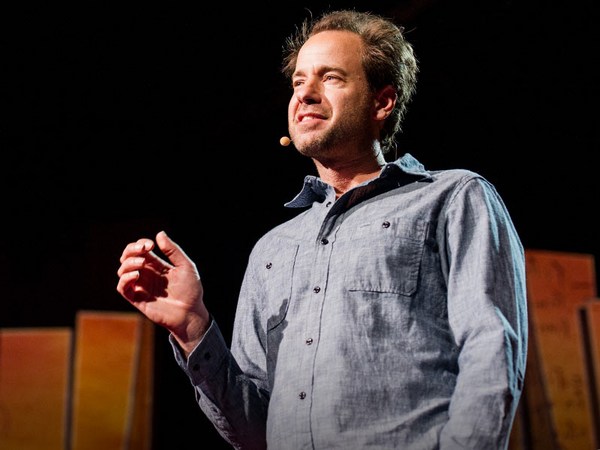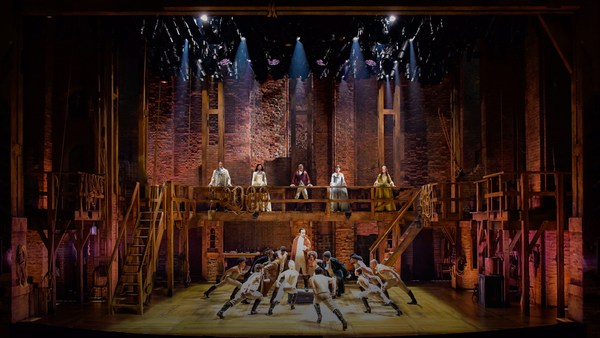There's a beautiful statement on the screen that says, "Light creates ambiance, light makes the feel of a space, and light is also the expression of structure." Well, that was not by me. That was, of course, by Le Corbusier, the famous architect. And here you can see what he meant in one of his beautiful buildings -- the chapel Notre Dame Du Haut De Ronchamp -- where he creates this light that he could only make because there's also dark. And I think that is the quintessence of this 18-minute talk -- that there is no good lighting that is healthy and for our well-being without proper darkness.
So this is how we normally would light our offices. We have codes and standards that tell us that the lights should be so much Lux and of great uniformity. This is how we create uniform lighting from one wall to the other in a regular grid of lamps. And that is quite different from what I just showed you from Le Corbusier. If we would apply these codes and standards to the Pantheon in Rome, it would never have looked like this, because this beautiful light feature that goes around there all by itself can only appear because there is also darkness in that same building. And the same is more or less what Santiago Calatrava said when he said, "Light: I make it in my buildings for comfort." And he didn't mean the comfort of a five-course dinner as opposed to a one-course meal, but he really meant the comfort of the quality of the building for the people. He meant that you can see the sky and that you can experience the sun. And he created these gorgeous buildings where you can see the sky, and where you can experience the sun, that give us a better life in the built environment, just because of the relevance of light in its brightness and also in its shadows.
And what it all boils down to is, of course, the sun. And this image of the Sun may suggest that the Sun is something evil and aggressive, but we should not forget that all energy on this planet actually comes from the Sun, and light is only a manifestation of that energy.
The sun is for dynamics, for color changes. The sun is for beauty in our environment, like in this building -- the High Museum in Atlanta, which has been created by Renzo Piano from Italy, together with Arup Lighting, a brilliant team of lighting designers, who created a very subtle modulation of light across the space, responding to what the sun does outside, just because of all these beautiful openings in the roof. So in an indirect way, you can see the sun. And what they did is they created an integral building element to improve the quality of the space that surrounds the visitors of the museum. They created this shade that you can see here, which actually covers the sun, but opens up to the good light from the sky. And here you can see how they really crafted a beautiful design process with physical models, with quantitative as well as qualitative methods, to come to a final solution that is truly integrated and completely holistic with the architecture. They allowed themselves a few mistakes along the way. As you can see here, there's some direct light on the floor, but they could easily figure out where that comes from. And they allow people in that building to really enjoy the sun, the good part of the sun.
And enjoying the sun can be in many different ways, of course. It can be just like this, or maybe like this, which is rather peculiar, but this is in 1963 -- the viewing of a sun eclipse in the United States. And it's just a bit bright up there, so these people have found a very intriguing solution. This is, I think, a very illustrative image of what I try to say -- that the beautiful dynamics of sun, bringing these into the building, creates a quality of our built environment that truly enhances our lives. And this is all about darkness as much as it is about lightness, of course, because otherwise you don't see these dynamics.
As opposed to the first office that I showed you in the beginning of the talk, this is a well-known office, which is the Weidt Group. They are in green energy consulting, or something like that. And they really practice what they preach because this office doesn't have any electric lighting at all. It has only, on one side, this big, big glass window that helps to let the sunlight enter deep into the space and create a beautiful quality there and a great dynamic range. So it can be very dim over there, and you do your work, and it can be very bright over there, and you do your work. But actually, the human eye turns out to be remarkably adaptable to all these different light conditions that together create an environment that is never boring and that is never dull, and therefore helps us to enhance our lives.
I really owe a short introduction of this man to you. This is Richard Kelly who was born 100 years ago, which is the reason I bring him up now, because it's kind of an anniversary year. In the 1930s, Richard Kelly was the first person to really describe a methodology of modern lighting design. And he coined three terms, which are "focal glow," "ambient luminescence" and "play of the brilliants" -- three very distinctly different ideas about light in architecture that all together make up this beautiful experience.
So to begin with, focal glow. He meant something like this -- where the light gives direction to the space and helps you to get around. Or something like this, which is the lighting design he did for General Motors, for the car showroom. And you enter that space, and you feel like, "Wow! This is so impressive," just because of this focal point, this huge light source in the middle. To me, it is something from theater, and I will get back to that a little bit later. It's the spotlight on the artist that helps you to focus. It could also be the sunlight that breaks through the clouds and lights up a patch of the land, highlighting it compared to the dim environment. Or it can be in today's retail, in the shopping environment -- lighting the merchandise and creating accents that help you to get around.
Ambient luminescence is something very different. Richard Kelly saw it as something infinite, something without any focus, something where all details actually dissolve in infinity. And I see it as a very comfortable kind of light that really helps us to relax and to contemplate. It could also be something like this: the National Museum of Science in London, where this blue is embracing all the exhibitions and galleries in one large gesture.
And then finally, Kelly's play of brilliants added to that really some play, I think, of the skyline of Hong Kong, or perhaps the chandelier in the opera house, or in the theater here, which is the decoration, the icing on the cake, something playful, something that is just an addition to the architectural environment, I would say. These three distinct elements, together, make a lighting environment that helps us to feel better. And we can only create these out of darkness. And I will explain that further. And I guess that is something that Richard Kelly, here on the left, was explaining to Ludwig Mies van Der Rohe. And behind them, you see that Seagram Building that later turned into an icon of modern lighting design.
Those times, there were some early attempts also for light therapy already. You can see here a photo from the United States Library of Medicine, where people are put in the sun to get better. It's a little bit of a different story, this health aspect of light, than what I'm telling you today. In today's modern medicine, there is a real understanding of light in an almost biochemical way. And there is the idea that, when we look at things, it is the yellow light that helps us the most, that we are the most sensitive for. But our circadian rhythms, which are the rhythms that help us to wake and sleep and be alert and relaxed and so forth and so on, they are much more triggered by blue light. And by modulating the amount of blue in our environment, we can help people to relax, or to be alert, to fall asleep, or to stay awake.
And that is how, maybe in the near future, light can help hospitals to make people better sooner, recover them quicker. Maybe in the airplane, we can overcome jet lag like that. Perhaps in school, we can help children to learn better because they concentrate more on their work. And you can imagine a lot more applications. But I would like to talk further about the combination of light and darkness as a quality in our life.
So light is, of course, for social interaction also -- to create relationships with all the features around us. It is the place where we gather around when we have to say something to each other. And it is all about this planet. But when you look at this planet at night, it looks like this. And I think this is the most shocking image in my talk today. Because all this light here goes up to the sky. It never reaches the ground where it was meant for. It never is to the benefit of people. It only spoils the darkness. So at a global scale, it looks like this. And, I mean, that is quite amazing, what you see here -- how much light goes up into the sky and never reaches the ground. Because if we look at the Earth the way it should be, it would be something like this very inspiring image where darkness is for our imagination and for contemplation and to help us to relate to everything.
The world is changing though, and urbanization is a big driver of everything. I took this photo two weeks ago in Guangzhou, and I realized that 10 years ago, there was nothing like this, of these buildings. It was just a much smaller city, and the pace of urbanization is incredible and enormous. And we have to understand these main questions: How do people move through these new urban spaces? How do they share their culture? How do we tackle things like mobility? And how can light help there? Because the new technologies, they seem to be in a really interesting position to contribute to the solutions of urbanization and to provide us with better environments.
It's not that long ago that our lighting was just done with these kinds of lamps. And of course, we had the metal-halide lamps and fluorescent lamps and things like that. Now we have LED, but here you see the latest one, and you see how incredibly small it is. And this is exactly what offers us a unique opportunity, because this tiny, tiny size allows us to put the light wherever we really need it. And we can actually leave it out where it's not needed at all and where we can preserve darkness. So that is a really interesting proposition, I think, and a new way of lighting the architectural environment with our well-being in mind. The problem is, though, that I wanted to explain to you how this really works -- but I can have four of these on my finger, so you would not be able to really see them. So I asked our laboratory to do something about it, and they said, "Well, we can do something." They created for me the biggest LED in the world especially for TEDx in Amsterdam.
So here it is. It's the same thing as you can see over there -- just 200 times bigger. And I will very quickly show you how it works. So just to explain. Now, every LED that is made these days gives blue light. Now, this is not very pleasant and comfortable. And for that reason, we cover the LED with a phosphor cap. And the phosphor is excited by the blue and makes the light white and warm and pleasant. And then when you add the lens to that, you can bundle the light and send it wherever you need it without any need to spill any light to the sky or anywhere else. So you can preserve the darkness and make the light. I just wanted to show that to you so you understand how this works.
(Applause)
Thank you.
(Applause)
We can go further. So we have to rethink the way we light our cities. We have to think again about light as a default solution. Why are all these motorways permanently lit? Is it really needed? Can we maybe be much more selective and create better environments that also benefit from darkness? Can we be much more gentle with light? Like here -- this is a very low light level actually. Can we engage people more in the lighting projects that we create, so they really want to connect with it, like here? Or can we create simply sculptures that are very inspiring to be in and to be around? And can we preserve the darkness? Because to find a place like this today on Earth is really very, very challenging. And to find a starry sky like this is even more difficult.
Even in the oceans, we are creating a lot of light that we could actually ban also for animal life to have a much greater well-being. And it's known that migrating birds, for example, get very disoriented because of these offshore platforms. And we discovered that when we make those lights green, the birds, they actually go the right way. They are not disturbed anymore. And it turns out once again that spectral sensitivity is very important here.
In all of these examples, I think, we should start making the light out of darkness, and use the darkness as a canvas -- like the visual artists do, like Edward Hopper in this painting. I think that there is a lot of suspense in this painting. I think, when I see it, I start to think, who are those people? Where have they come from? Where are they going? What just happened? What will be happening in the next five minutes? And it only embodies all these stories and all this suspense because of the darkness and the light.
Edward Hopper was a real master in creating the narration by working with light and dark. And we can learn from that and create more interesting and inspiring architectural environments. We can do that in commercial spaces like this. And you can still also go outside and enjoy the greatest show in the universe, which is, of course, the universe itself. So I give you this wonderful, informative image of the sky, ranging from the inner city, where you may see one or two stars and nothing else, all the way to the rural environments, where you can enjoy this great and gorgeous and beautiful performance of the constellations and the stars.
In architecture, it works just the same. By appreciating the darkness when you design the light, you create much more interesting environments that truly enhance our lives. This is the most well-known example, Tadao Ando's Church of the Light. But I also think of Peter Zumthor's spa in Vals, where light and dark, in very gentle combinations, alter each other to define the space. Or Richard MacCormac's Southwark tube station in London, where you can really see the sky, even though you are under the ground.
And finally, I want to point out that a lot of this inspiration comes from theater. And I think it's fantastic that we are today experiencing TEDx in a theater for the first time because I think we really owe to the theater a big thanks. It wouldn't be such an inspiring scenography without this theater. And I think the theater is a place where we truly enhance life with light.
Thank you very much.
(Applause)





